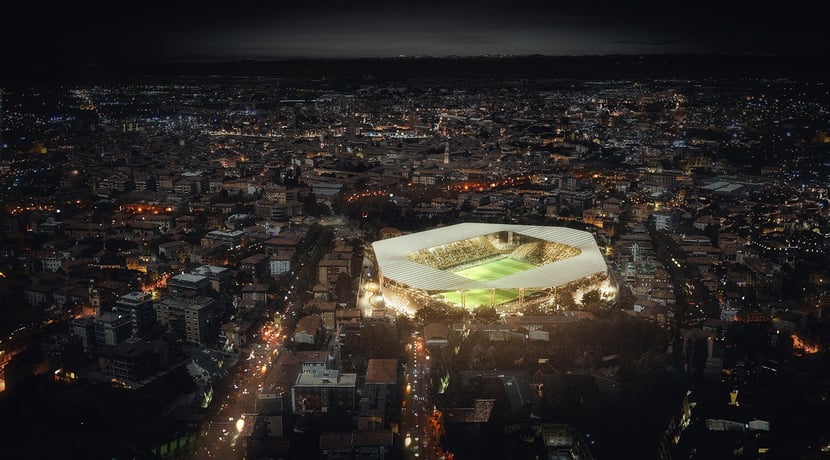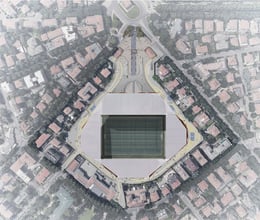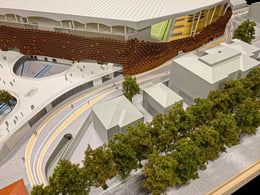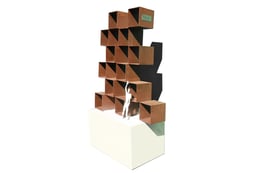Accedi
Utenti registrati

The functional redevelopment of the Ennio Tardini Stadium originates from the need of Parma Calcio 1913 to provide itself a state of art football facility designed to enhance the sports experience both for spectators and members of the team, while providing the city of Parma with a range of new high-quality areas and services accessible. Having chosen not to build a brand-new stadium in the outskirts of the city and to refurbuish the current one in its original location, created and indissoluble bond between the creative process and the historical research in the name the respect of the city’s tradition. Gaps, roads, colours, and materials as a base for contemporary reinterpretation of red bricks of the Palazzo della Pilotta and the Duomo, of the bright-paved lanes that cross Parco Ducale, of the Parma Yellow and, obviously, the blue and the yellow landmark colours of the city and the club. Currently inaccessible in non-match days, the 20.000m2 area surrounding the stadium will be subject to a radical redevelopment and become available at every time thanks to the relocation of the maximum safety perimeter from the external perimeter wall and gates to the façade of the venue itself. A newly accessible public space that aspires, with its quality, to become attractive for the local community, contributing to the setting of a new reference standard for future Italian stadiums. The broad, tarmac-paved clearing between the stadium and the monumental arch will then be transformed into an attractive and high-quality plaza, where access ramps to the stands will be integrated with retail, catering and the Parma Calcio Museum. The arch itself, along with the two gatehouses, will undergo a complete preservation process, keeping on serving its original function of triumphal access to the stadium in a completely refurbished frame. Regardless of the level of service, stands have been designed to provide optimal visibility from every seat, following the most recent regulatory standards and indications in terms of safety and comfort, in compliance with the provisions provided by the latest “UEFA Quality Stadiums” manuals. In addition, after more than a century, the Tardini stadium will feature a complete grandstand roof integrating lighting, sound systems and sound damping and control functions. In a context of top-down requalification of the venue, the currently poor experience that can be provided to the general admission, along with an outdated hospitality in need of improvement, will have the possibility to be completely revised and broadened thanks to a design philosophy that puts the spectators at its fulcrum. Whether it’s general admittance or skyboxes, the new stadium will allow to dramatically uplift general comfort and experience at every level, with the aim to provide Parma with an attractive, inclusive, and safe football stadium, capable to attract a broader range of public. All the major hospitality and spectators’ experience functions will be hosted within the Petitot grandstand: designed as a large building on 7 floors, facing the main square on one side, will feature world-class lounges, skyboxes and press services, along with a broad food and beverage offer that will range from bars to high end restaurants, allowing to meet the highest UEFA standards in terms of comfort, safety and experience. Within the limitations of the strict Italian safety laws, the intent was to bring spectators as close as possible to the football field. First of a kind for Italian stadiums, the Petitot grandstand will feature a full-length loggia at an elevation of only one meter from the pitch, provided with upper end bars, a restaurant, and seats just next to the players’ benches and the changing rooms glazed tunnel. Upper floors will host lounges dedicated to higher levels of service, culminating with the skyboxes of the top floor. 21 private spaces, of which 5 conceived as “superboxes”: fully-fledged small luxury apartments on two floors, fitted with internal restrooms a dedicated accessibility. The new Ennio Tardini stadium aims to maintain its status as an icon of its city, uplifting its offer to the public and updating its look without breaking its strong bonds with its own history and the city. A stadium designed to exist nowhere else in the world than in Parma. For the façade, a bright Cor-Ten steel was analysed and tested. The intention was to transpose the materiality of local red bricks while meeting the structural and safety needs of steel, using a coating that, like terracotta and unlike synthetic painted coatings, could grow, age, and change its look evolving and blending with the environment. The organic, cloud-like development of its constituting basic elements (a repeated cubic, open box of one meter side) it’s the result of a synthesis of several constraints like, among others, keeping an increased distance from the area perimeter, sound diffraction, sun shading and maximization of floor area available at ground level to make spectators flow around the venue at the end of the game. Keeping all these constraints together on such a complex system, while making it easily buildable and maintain costs under control, was made possible through algorithmic design. The façade was therefore designed in 8 macro-sections in which the single elements are parallel to each other. The offset of each box over the other is controlled in a way that the finished façade can’t be climbed at any point. The process reached such an accuracy and control of every single one of the 6000 façade elements that mounting schemes and parts list were directly derived from the algorithm. The familiar appearance of Cor-Ten steel, the modular development of the façade elements and the organic, yet understated look will allow the new Ennio Tardini to become a brand new landmark that, ironically, will look as it has always been there: A stadium inspired by the past looking to future.






























Studio Zoppini was founded in 1961 by Pino Zoppini. The services provided range from architecture, urban planning with particular experience in advanced and complex large and small scale buildings.
Alessandro Zoppini has over 25 years experience in architectural design focusing mainly on sport and leisure facilities design. Alessandro is part of a very limited number of architects to have designed venues for three Olympic Games (Torino 2006, Sochi 2014, PyeongChang 2018).
Following work experience at Arup Associates and RPBW Architects he was partner at Studio Zoppini where took active role from the conception to the construction of all projects. From 2015 to January 2019 he was Director at Gensler in London as head of EMEA Sport Sector with global responsibility for large Events.
He has won several Architectural Prizes including IOC Gold Medal Award for the design of the Oval for the Turin 2006 Winter Olympics and is a frequent speaker at international Architectural conferences.
https://www.studiozoppini.it/i...